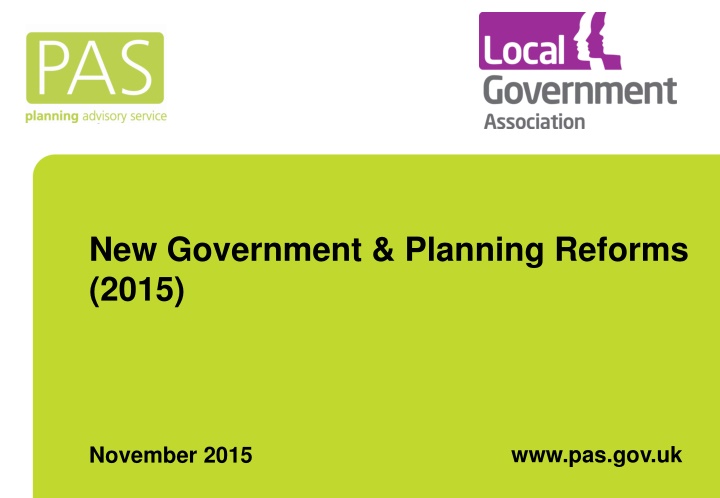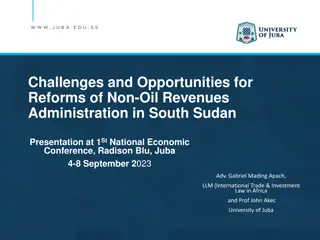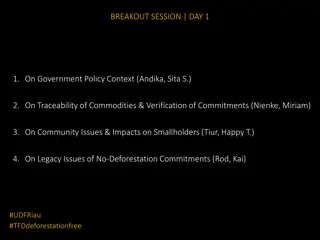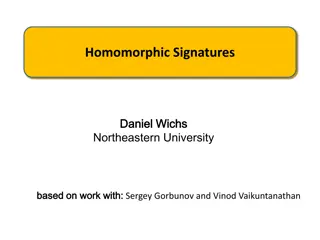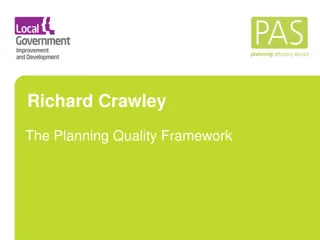Government Planning Reforms & Manifesto Commitments 2015
Comprehensive overview of government planning reforms from 2010-15, including priorities, manifesto commitments, and productivity plan measures. Emphasizes housing supply, home ownership, local growth, public services, and protection of green spaces. Highlights simplification of policies, community engagement, infrastructure provisions, and sustainable development initiatives.
Download Presentation

Please find below an Image/Link to download the presentation.
The content on the website is provided AS IS for your information and personal use only. It may not be sold, licensed, or shared on other websites without obtaining consent from the author.If you encounter any issues during the download, it is possible that the publisher has removed the file from their server.
You are allowed to download the files provided on this website for personal or commercial use, subject to the condition that they are used lawfully. All files are the property of their respective owners.
The content on the website is provided AS IS for your information and personal use only. It may not be sold, licensed, or shared on other websites without obtaining consent from the author.
E N D
Presentation Transcript
New Government & Planning Reforms (2015) www.pas.gov.uk November 2015
DCLG Priorities Driving up housing supply Increasing home ownership Devolving powers and budgets to boost local growth Supporting strong communities with excellent public services Manifesto Commitments - Budget - Productivity Plan Housing and Planning Bill 2
Planning reform 2010-15 Local Sustainable Simple Compulsory community consultation 1300 pages of policy down to less than 50 NPPF and Guidance Review Localism Act Robust Evidence of need and 5 year land supply Regional Strategy revocation Duty to cooperate 6000 page s of guidance reduced and now on web Presumption in favour of sustainable development Neighbourhood Planning Strong protections still in place Tackling LA poor performance Proportionate Effective Conditions EIA Thresholds Deregulation and Simplification Speeding up appeals Growth and Infrastructure Act & Infrastructure Act NSIP Use Class Order Award of costs Community Infrastructure Levy Statutory consultees Major Information requirements Permitted development rights Unblocking stalled sites Infrastructure Section 106
Manifesto commitments 200,000 Starter Homes for first time buyers by 2020 Right to Build for local people to build/commission a home More than 90% of suitable brownfield sites have planning permission for housing by 2020 Strong protection for the Green Belt and other designations Ensure communities know up-front that necessary infrastructure will be provided when new homes are permitted Encourage communities engaged in neighbourhood planning to complete the process, and let people have more say over local planning Give local people the final say on wind farm applications Support safe development of shale gas 4
Productivity Plan (main measures) Local plans: streamlining, and in place by 2017 Permission in principle allocated sites, brownfield register, small sites Minors introduced into designation regime Housing in major infrastructure projects S106 dispute resolution mechanism Review of Compulsory Purchase powers Maximising release of unnecessary employment land for housing, and supporting higher density development around commuter hubs Reviewing threshold for converting agricultural buildings under PD. London threshold for call in; building up
And now the autumn statement Local plans - a delivery test on local authorities, to ensure delivery against the homes set out in local plans within a reasonable timeframe. Neighbourhood plans- allocations even if not in local plan Starter homes - ensure the release of unused and previously undeveloped commercial, retail and industrial land for Starter Homes; support regeneration of brownfield sites in the greenbelt, by allowing them to be developed in the same way as brownfield sites elsewhere, providing it delivers Starter Homes. Subject to local consultation, such as through neighbourhood plans.
Autumn statement (cont) Decision making amend quality (appeals) performance measure by lowering the threshold for the quality of decisions to 10% of all major decisions overturned on appeal Conditions review operation of deemed discharge S106s - a more standardised approach to viability assessments, and extend the ability to appeal against unviable section 106 agreements to 2018. SMEs - halve the length of the planning guarantee and amend planning policy to support small sites, while ensuring protection for existing gardens.
This presentation Doesn t cover everything Does introduce changes in the Bill relating to: Brownfield land registers Permissions in principle Starter homes Right to build Performance Local plan intervention Housing in major infrastructure projects Office to residential permitted development Neighbourhood planning
Housing and Planning Bill Had its second reading on 2 November Scrutinised by Committee Committee will hear evidence through November and December 2015 Ping pong between the Houses Act early next year
Brownfield land: the register and permissions in principle
Those obstacles. Where development proposals require individual planning permission and are subject to detailed and discretionary scrutiny slow, expensive and uncertain process reduces the appetite to build.
Fixing the foundations. July 2015 The government is clear on the need to promote use of brownfield land, and will remove all unnecessary obstacles to its re-development
Brownfield Land National Planning Policy Framework Planning policies and decisions should encourage the effective use of land by re- using brownfield land provided that it is not of high environmental value. Local councils can set locally appropriate targets for using brownfield land. Manifesto Commitments Ensure that brownfield land is used as much as possible for new development. Require local authorities to have a register of what is available, and ensure that 90 per cent of suitable brownfield sites have planning permission for housing by 2020. Statutory Register Will improve the availability and transparency of information, providing certainty and encouraging investment. Help to measure progress in delivering permissions.
Consultations and Incentives Consultation Jan 2015 Introduced Brownfield register: LPAs required to ensure that 90% of sites of the register have planning permissions in place by 2020 Envisaged planning permissions or local development orders Penalties for LPAs who did not succeed
Brownfield Register Housing and Planning Bill (Clause 103) Councils will be required to compile a register of previously developed land in their area which is suitable for housing The criteria for which land should be placed on the register will come in secondary legislation
Brownfield Register Permission in principle to be granted for suitable sites on local registers To exclude sites that require screening for EIA/HRA (which can be taken forward though the usual planning application route) and sites that have existing planning permissions Decisions about potential sites that are eligible for permission in principle will be for local authorities Draft list of potential sites to be subject to public consultation and consultation with statutory consultees
Brownfield Register Assume the site assessment/criteria to determine suitability for housing will be Based on SHLAA including annual reviews of potentially suitable sites Taking existing policy and guidance as its starting point is the site brownfield land as defined in NPPF? From the January consultation: Deliverable; Free of Constraint (that cannot be mitigated); Capable of Development; Capable of supporting 5 or more dwellings (on sites 0.25ha and above*) Reminder in the Bill that in determining which land should go on the register the LPA will have to have regard to the development plan, national policies, advice and guidance
Brownfield Register Register likely to be in several parts: Land suitable for housing that meets specified criteria Land in the part 1 register that the LPA considers is suitable for the grant of PiP and which has been through a consultation process (but not incl. land with planning permission) Land which does not meet the criteria, but which the LPA wishes to include e.g. suitable for 4 of fewer houses
Brownfield Register Possible exclusions: Indications of some discretion about including land where the development would be particularly controversial and the LPA considers that the decisions should be made through a planning application. Will this also include sites that would require EIA/ HRA appraisals?
Brownfield Register What information should be on the register? Site reference Address Size Estimate of the number of dwellings, Planning status DCLG consultation on implementation details coming soon
Brownfield Register Policy Aims: improve the availability and transparency of information, providing certainty and encouraging investment help to measure progress in delivering permissions build on existing plan making processes to avoid additional work Issue: How to incentivise the development of previously developed land, given that this land may have higher development costs
Housing and Planning Bill Permissions in principle Two kinds of Permissions in Principle (PiPs) (clause 102) By application decided by councils for small sites Granted by the SoS through a development order Councils will hold a register of all PiPs ( both kinds) Not retrospective
Permissions in Principle The model Technical Details Consent (TDC) Permission in Principle (PIP) Permission to Build Permission in principle (PiP) certainty on in principle issues of land use, the location and the amount of development Technical Details Consent (TDC) Sufficient process to deal with technical matters
Permissions in Principle Type 1: granted by development order S59(A) Type 2: granted by councils S59(A) (i) Plan and Registers grant permission in principle Application for permission in principle (Small sites) Neighbourhood Plan Brownfield register Local Plan Application for Technical Detail Consent (S70)
Permission in principle by Development Order Initially only land allocated in brownfield register, DPDs and NPs The Order will set out type and scope of development to be granted PiP Current intention is that this will be for housing sites Will indicate site, location and amount of development PiP will only be granted when the register, DPD or NP is adopted or made by the council The Order will specify how long the PiP will last and what transitional arrangement will follow when the PiP expires
Permission in principle by application Applications likely to be for less than 10 units Procedure Order (the DMPO) will specify the steps for the council to take following an application Councils cannot grant PiP subject to conditions Councils will set out steps for a technical detail consent application
Permissions in principle Technical details consent Fee consistent with applications fees for similar development Can t reopen the principle of development through a TDC application Conditions can be imposed at this stage PiP may not bind where there has been a change of circumstances .
Permissions in principle Policy Aims Up front, binding certainty on fundamental issues for all users reducing upfront costs/resource Improve the efficiency of the planning system by minimising repeated effort by both developers and local planning authorities Some Issues How to ensure upfront certainty on in principle issues before getting into detailed, technical considerations?
The package Questions: Has the 90% requirement been dropped? Will the existing SHLAA process give LPAs enough confidence in the principle of development? Deliverability more viability testing - who pays? More up front work for Councils (and neighbourhood groups) at a time of tough resource constraints? Consultation with communities and statutory consultees? Appeals by both landowners and by neighbours Will it impact on plan preparation? Transition arrangements for plans/ allocations already in place?
The package Big Questions for the development community: Will the brownfield register provide information of site availability that at present you don t have access to? Will the permission in principle reduce uncertainty in the planning process enough to give you better access to funding?
Starter Homes From The Guardian March 2015
Starter Homes For sale at a maximum of 8O% of market rates 20% saving from removal of S106 and CIL Limited to first time buyers under 40 Price reduction will last for 5 years After which the property will be sellable at full market rate Price to be capped at 450k in London and 250k elsewhere Be available on all reasonable sized sites
Starter Homes LPAs to have a duty to "carry out its relevant planning functions with a view to promoting the supply of starter homes" LPAs will be able to negotiate the tenure of houses with a developer But Starter Homes would be a priority 200,000 target by 2020
Self (custom) build or Right to Build Bill amends the Self-build and Custom Housebuilding Act 2015 Which requires local authorities to keep a register of people seeking to acquire land to build or commission their own home Bill requires authorities to grant sufficient suitable development permission of serviced plots of land to meet the demand based on this register (pp or PIP)
Local authority can set criteria For example: You are aged over 18 You have a local connection to the district of East Hampshire (outside the South Downs National Park) You are, or will be, in a position financially to progress a self-build or custom-build project The property will be your main home
Some things to think about Are they likely to be delivered (viability, house prices)? What is your need and will you need to update your SHMA? What impact will this have on finances and resources (reduced S106/CIL)? Impact on affordable housing provision? Who will monitor/manage? Who will establish at least 20% below market price ?
A plan led system The Government want to see total plan coverage by end of Parliament They want a plan led system Local / Strategic Plans (October 2015) Number of LPAs Percentage of (336) LPAs 58 17% 83% 79% 67% 65% Not Published Published Submitted to SofS Found Sound Adopted 278 265 226 220
Intervention early 2017 Bill allows for SoS to intervene to bring LPA plans forward A deadline of early 2017 for plans to be produced The Government: it will intervene to arrange for the plan to be written, in consultation with local people, to accelerate production" Brandon Lewis to the select committee: DCLG would "not necessarily" write plans itself in cases where no local plans have been produced by early 2017
Local plan intervention We don t know: how an intervention will work? who would do it? LPA with help, another local authority? PINs,? what early 2017 means (NPPF anniversary)? what a produced plan is? adopted? submitted? published? ???
Local plan intervention There is potential to extend this intervention to pre NPPF plans!!
Local plan review The Government set up the Local Plans Expert Group in Sept 2015 to advise on streamlining the local plan process Request for Evidence closed - end Oct 2015 Due to report findings - end of Feb 2016 They don t want to be late, gather disproportionate amounts of evidence, or right a really, really, long report
Local plan review The review s focus is on how plans are: prepared by LPAs examined adopted with an aim of speeding up the process. It aims to identify barriers to local plan-making and make proposals on how to improve the process.
Local plan review - specifically are plans are taking on too many issues how the process is resourced better collaboration between authorities to produce plans together, how strategic housing need is addressed, the duty to cooperate process, evidence requirements for a plan, and tackling political differences stopping plans emerging.
Questions Will this affect you presently? Will it alter your present timetable for production? If the process applies to pre NPPF plans (pre 2012) would this affect you? Would it alter you timetable for updating? Will this affect how you are resourcing your planning policy? Might you, secretly, be quite pleased?
Permitted Development - office to residential Introduced 2013 - 2016 as temp PD right Popular with developers Government saw it as a way of reusing redundant office buildings to increase housing stock Announced it will be made permanent and expanded to include demolition and rebuild of office buildings for new resi B1(c) (light industrial)
Permitted Development - office to residential Extension of PD right will be subject to prior approval by LPA Expected B1(c) conversions subject to impact on neighbouring employment uses not being unacceptable meaning of this uncertain; will be probably be decided by the Courts!
Permitted Development - office to residential Previously secured prior approvals under present right will have extra 3 years to complete the change of use extending date to May 2019 (from May 2016) The present 17 exemption areas will remain until May 2019 then need to have an Article 4 direction to remove PD right
Housing and nationally significant infrastructure projects NSIPs are usually large-scale developments (relating to energy, transport, water, or waste) which require a type of consent known as development consent 2013 allowed some business and commercial projects to be included A DCO removes the need to obtain several separate consents, including planning permission is designed to be a much quicker process than applying for these separately.
Housing and NSIPs Bill/Regs allows SoS to grant development consent for housing which is linked to an application for an NSIP eg for construction workers And also where no functional link, but a close geographical link (up to a mile away) Where no functional link must include affordable and starter homes Up to 500 dwellings
Planning application performance Major apps performance target 50% in 13 weeks (excl. EoT, PPAs & EIAs) over a rolling two year period. This target has increased over time LPAs inside the target are designated If designated applicants have option to go to PINs for decision rather than LPA And have to do an improvement plan And get above the threshold for de-designation
